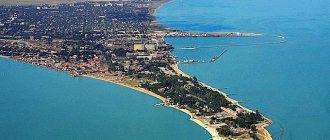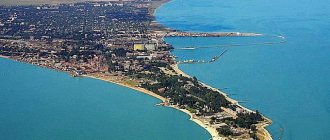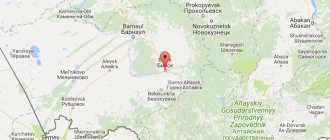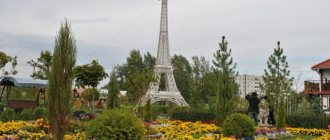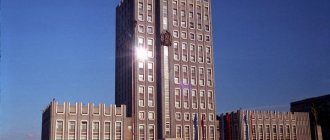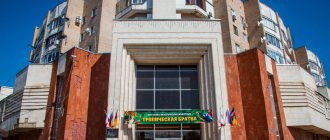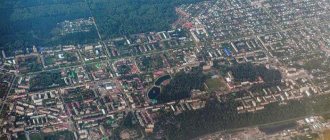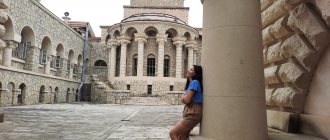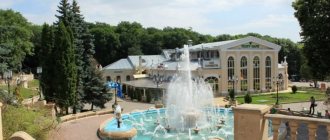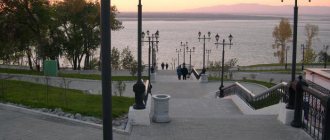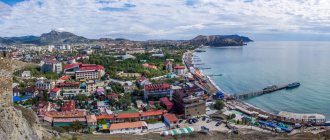The city of Essentuki is located in a special ecological resort zone - Caucasian Mineral Waters. Essentuki became famous due to its mild continental climate and mineral water with unique healing properties. The town is small, cozy, a lot of greenery. It’s not the capital, of course, but all the necessary infrastructure is there and functions all year round, because people come here from different parts of the country and even the world, all year round.
The population of Essentuki is just over 100 thousand people. Territory: 50 km². Moscow time.
The name Essentuki is associated with the name of a local feudal lord, who was even a descendant of Genghis Khan. His name was Essen. The name of the place passed on to the Cossacks who stood patrol here, and then it came down to the present day. The name of the city is well known even to those who have no idea where it is. The reason for this is the bottles with the inscription “Essentuki-17” and “Essentuki-4” on store shelves, which are familiar to residents throughout Russia.
Mineralnye Vody is 43 km from Essentuki and 17 km to the city of Pyatigorsk. Height above sea level 640 meters. Located in the steppe area, in the valley of the Podkumok River.
A resort area has been designated in Essentuki. It is located south of the railway line, so there is no need to cross or under the tracks, as in Adler. The area of the resort area is about 7% of the total area of the city.
General information and history of the city
Russia is a country rich in all kinds of holidays, sometimes lasting for weeks. But the result of such endless feasts can be stomach problems, and for some, even worse: a terrible hangover. Well, who hasn’t gotten rid of these ailments with mineral water “Essentuki-17” and “Essentuki-4”?
So, for those who don’t know, Essentuki is not just water, but a resort city in the south of our country, a quiet and cozy corner of the Caucasian Mineral Waters. Back in the 19th century, a Volga Cossack detachment came across unpleasant-smelling and salty-tasting springs in this area in a swampy area near the Kislusha stream. The Cossacks did not drink from the springs, but their horses could not be pulled away from this water. This is how the main means of modern Essentuki treatment were discovered - mineral springs and healing mud.
Essentuki is located in the southern part of the Stavropol Territory, on a flat foothill on the northern slopes of the Caucasus Range. The area of the city is approximately 50 km2 and is located along the Podkumok River.
Climate and ecology of Essentuki
The geographical location of Essentuki determines the climate of this city - here it is continental, mountain-steppe, characterized by a pronounced seasonal contrast, that is, the summer here is hot and dry, the winter is cool and snowy, the autumn is foggy, and the spring is warm, but very short, just over a month.
In the spa healing park
Since there are no enterprises in Essentuki that pollute the air with their waste, it is a fairly clean city from an environmental point of view.
Why pay more? Popular Internet meme on the topic of flooding in Essentuki
And yet, problems did not escape this resort. Firstly, the mountains located near the city are not only beautiful, but also radioactive contamination coming from some rocks. Secondly, such a scourge of modern cities as car exhaust fumes. Thirdly, pollution of nearby water bodies through the discharge of untreated wastewater. Fourthly, spontaneous and illegal landfills within the city and its immediate surroundings. And finally, fifthly, littering the city by the citizens themselves.
Essentuki
(Stavropol region)
OKATO code:
07410
Founded:
1825
City since:
1917 City of regional subordination
Telephone code (reference phone)
| 86534***** | 62-00-0 |
Deviation from Moscow time, hours:
0
Geographic latitude:
44°02′
Geographic longitude:
42°51′
Altitude above sea level, meters:
610 Sunrise and sunset times in the city of Essentuki
City population
The population of the city of Essentuki has exceeded 100 thousand people. Most of the population are people of working age, a smaller part are pensioners and a very small part are those who are under 16 years old. If you don’t delve too deeply into the calculations, the approximate figures are as follows: 60% in the first group, 24% in the second and 16% in the third.
For various reasons, people who come from other cities and even states become Essentu residents; for example, in 2013 there were almost 2.5 thousand people.
Essentuki is home to a predominantly Russian population – about 80 thousand people. Other nationalities are represented by Greeks, more than 10 thousand, and Armenians, more than 8 thousand. Also on the territory of the resort city there are Ukrainians, Azerbaijanis, Georgians, Ossetians, Karachais, Kabardins, peoples from Dagestan, and it is worth mentioning the Cossacks.
People in Essentuki, as befits normal resort residents, are polite, cultured, friendly and responsive. Locals understand perfectly well that it is thanks to tourists that the city lives and develops. Therefore, a lost guest will not have to worry - help will always be provided here and directions will be given. Well, this again, if you meet a normal resident of the resort. It also happens that after talking with some aborigine, who is indifferent at best, you get the feeling that you were not expected here, but that you were right in there.
Religion
Old Believers-Ynglings
- Slavic community of Orthodox Old Believers-Ynglings “Children of Perun”.
Russian Orthodox Church
- Church of the Holy Great Martyr and Healer Panteleimon.
- St. Nicholas Church, built by the Cossacks in 1826.
Muslims
Mosque named after Prophet Muhammad
Hare Krishnas
Krishna Temple in Essentuki
Jehovah witnesses
- Organization of Jehovah's Witnesses.
Church of Evangelical Christian Baptists
ECB Prayer House.
Christians of the Evangelical Faith (Pentecostals)
- Church "Love of Christ the Savior".
Old Believers
- Holy Intercession Old Believer Church.
Districts and real estate of Essentuki
Although there are no official administrative districts in Essentuki, the city is still divided into microdistricts. They are called simply: Microdistrict 1, Microdistrict 2, Microdistrict 3, Microdistrict 4, as well as Severny, Opytnik, Beshtaugorets, Zapolotnyanka, Drop beam. The schematic map of Essentuki looks like this.
Essentuki Map
Historically, urban development in Essentuki is located on the left bank of the Podkumok River and stretches for 13 kilometers along it. And, as practice shows, even a small territory of a settlement requires geographical separation for the convenience of life. So these Essentuki kilometers were also divided. There are microdistricts here with numbers: No. 1, No. 2, No. 3, No. 4 - they received their names in order of construction in the 60s. last century.
2 microdistrict
In Microdistrict No. 3, the districts Fantasia and Veteran are distinguished, or even these names are simply used as synonyms. Severny is a district located in the northern part of Essentuki. Microdistrict Opytnik, they say that in the post-war period there was an experimental farm for growing seedlings. The Beshtaugorets area offers a good view of Beshtau, perhaps hence the name.
Beshtaugorets
Zapolotnyanka is located behind the railway track, which runs through the city center.
Drop beam is an area located in the northeast of the city; There is a large ravine with an active watercourse here. In addition to these areas, local residents name more than a dozen more districts. The most famous are White Coal (the first hydroelectric power station in Russia appeared here, which began to be called White Coal); Green (once there was a market here where only greens were sold: fruits, vegetables, flowers); Resort area (an area that includes parks, drinking galleries, sanatoriums, mud baths);
Resort (adjacent to the resort area with residential buildings); Pribrezhny (territory occupied by the construction of houses for flood victims in 2002); Stroitel (the area where there used to be a sports complex for builders, and today the Stroitel hotel). Well, if you are dividing to the point of fanaticism, then in Essentuki there are still the districts Brick, the Victoria sanatorium, Aquawhite, Aerodrome, Upper Market, Railway Station, Infectious Diseases Hospital, Furniture Factory, Medical School, Mill, Lower Market, Lake, Glass, School No. 5, school No. 9, Teleatelier, Yuzhny and others.
If we talk about the most developed areas, then these are Microdistrict No. 3 (“Fantasy”, “Veteran”), “Resort” and “Resort Zone”, located in the center. It’s best to live in “Fantasy”; it has kindergartens, schools, shops, a swimming pool, a market, a nightclub, a cinema, as well as the tax office and Sberbank; nearby are a maternity hospital, a city hospital and an ambulance station.
Fantasy
In addition, from here you can get to any part of the city by public transport without transfers. In the center of the city, divided by a railway, there are sanatorium-resort institutions, two parks: Lechebny and Pobedy, the Spartak stadium, quarters of historical Cossack buildings, station square, and administrative buildings. Such historically established residential formations as White Coal, Kapelnaya Balka, Zapolotnyansky (Zapolotnyanka), Yuzhny, Severny, Zolotushka are geographically separated, which has a negative impact on transport links between these areas and the scope of their services.
In Essentuki, until recently, the predominant housing was private households, but now many new buildings have appeared, especially in Microdistrict No. 4, Kapelnaya Balka, a small section of Microdistrict No. 3. But, of course, there are also many dilapidated estates, in particular in Microdistrict No. 2. For those interested to buy new housing in Essentuki, you will have to spend money on repairs, since most of it is rented, as they say, with bare walls.
You can also buy an apartment on the secondary market in a house built 20 or 40 years ago. And it can be either small-sized or housing with an improved layout. Prices for private houses in Essentuki are around 5.5 million rubles, there are, of course, prices for 30 million rubles, and for apartments - an average of 36 thousand per square meter (and they rise almost daily).
Everyone can afford to buy housing in Essentuki. The question is finances and requests - it could be a room in a hostel or an old building in the center with partial amenities, and these homes can be purchased for 500-600 thousand rubles. But you may also like an elite apartment or mansion, and for them you will have to pay 15 million or more. One hundred square meters of land can be bought for 280-300 thousand rubles, and office space costs almost 50 thousand per m2. It is clear that people often come to the resort just to relax, and not for permanent residence, and in this case it is enough to simply rent an apartment. Renting an apartment in Essentuki averages 10.5 thousand rubles per month.
Map
| Essentuki: maps |
Essentuki: photo from space (Google Maps) Essentuki: photo from space (Microsoft Virtual Earth)
| Essentuki. Nearest cities. Distances in km. on the map (in brackets along roads) + direction. Using the hyperlink in the distance , you can get the route (information courtesy of the AutoTransInfo website) | |||
| 1 | Essentuki | 1 () | SE |
| 2 | Yasnaya Polyana | 6 () | Z |
| 3 | Winsads | 10 () | NE |
| 4 | Lermontov | 11 (28) | NE |
| 5 | Yutsa | 14 (20) | SE |
| 6 | Pyatigorsk | 15 (16) | IN |
| 7 | Freedom | 16 (20) | IN |
| 8 | Kislovodsk | 16 (21) | SW |
| 9 | Zheleznovodsk | 18 (23) | NE |
| 10 | Goryachevodsky | 19 () | IN |
| 11 | Inozemtsevo | 20 (22) | IN |
| 12 | Suvorovskaya | 23 (59) | NW |
| 13 | Konstantinovskaya | 24 () | IN |
| 14 | Uchkeken (Karachay-Cherkess Republic) | 28 (44) | Z |
| 15 | Andzhievsky | 29 () | NE |
| 16 | Mineral water | 30 (37) | NE |
| 17 | Pervomayskoye (Karachay-Cherkess Republic) | 31 () | Z |
| 18 | Zalukokoazhe (Kabardino-Balkarian Republic) | 32 () | SE |
| 19 | Levokumka | 32 (39) | NE |
| 20 | Lysogorskaya | 34 () | IN |
| 21 | Teresa (Karachay-Cherkess Republic) | 34 () | Z |
| 22 | Kamennomostskoye (Kabardino-Balkarian Republic) | 37 () | SE |
| 23 | Zolskaya | 38 () | IN |
| 24 | Sarmakovo (Kabardino-Balkarian Republic) | 42 () | SE |
| 25 | Kindly | 44 () | IN |
| 26 | Alexandria | 44 (59) | NE |
| 27 | Malka (Kabardino-Balkarian Republic) | 46 () | SE |
| 28 | Georgievsk | 50 (48) | IN |
| 29 | Podgornaya | 50 (55) | IN |
| 30 | Georgievskaya | 51 () | IN |
| 31 | Cuba (Kabardino-Balkarian Republic) | 51 () | SE |
a brief description of
The city is located in the south of the Stavropol Upland, at an altitude of 650 m, in the valley of the river. Podkumok, north of the foothills of the Rocky Range of the Greater Caucasus, 213 km southeast of Stavropol. Railway station on the Mineralnye Vody - Kislovodsk branch, 43 km southwest of Mineralnye Vody and 17 km west of Pyatigorsk.
Balneological and mud resort of all-Russian significance in the group of resorts of the Caucasian Mineral Waters.
The climate is moderate continental. Winter is mild, with thaws. The average January temperature is -4C; Sometimes there are significant frosts, and fogs are frequent. Spring is short, sometimes (usually in April) there is cool, rainy weather. Summers are warm, with many hot and dry days. The average temperature in July is +20C. Autumn is warm and long, the average temperature in September is about +15C. Precipitation is about 500 mm per year. Characterized by a large number of clear, sunny days (an average of 280 per year). The open position from the east makes Essentuki accessible to the prevailing winds here: dry eastern - hot in summer and cold in winter; humid southwestern - cool in summer and warm in winter.
Territory (sq. km): 50
Information about the city of Essentuki on the Russian Wikipedia website
Historical sketch
In 1798 on the right bank of the river. Bolshiye Essentuchyok, near its confluence with the river. Podkumok, the Russian military border redoubt of Essentuki was founded (abolished in 1803). The name is explained from the local toponym Esentuki - “the place (dwelling) of Yesan” (Esan is an Adyghe personal name, Miekuy is an Adyghe dialect “place”).
Buguntinsky mineral waters (originally named after the Bugunta river) were first explored in 1810 by Moscow doctor F.P. Haaz. In the valley of the Kislusha stream, approximately 4 km northeast of the Essentuki post, Gaaz discovered 2 small wells with sour-salty water (now the Gaazo-Ponomarevsky spring).
In 1823, Russian pharmacologist A.P. Nelyubin discovered 20 more mineral springs on the slopes of the mountain, which he named Alkaline (Nelyubin’s numbering of mineral waters in Essentuki has been preserved to this day).
In 1825, on the initiative of General A.P. Ermolova on the river Bugunta, 3.5 km northeast of the former Essentuki redoubt, the village of Essentuki was founded, its residents were engaged in trade, gardening and serving visiting patients. Since 1840, sources N4 and N17 came into use and became especially popular.
The village is becoming one of the best resorts for the treatment of diseases of the digestive system.
In 1846, by order of the governor of the Caucasus, Prince M.S. Vorontsov's territory of the Essentukskaya village was expanded to the northeast and came close to the sources. From that moment on, the Buguntin mineral waters began to be called Essentuki. In 1847, part of the lands immediately adjacent to the springs was transferred to the jurisdiction of the specially created state Water Directorate in Pyatigorsk.
At the end of the 1840s. the beginning was made of bottling Essentuki waters and sending them to other cities of the country.
The increase in the number of people coming for treatment to Essentuki was facilitated by the completion of construction in 1875. railway from Rostov-on-Don to Mineralnye Vody and a highway from Mineralnye Vody to Kislovodsk (via Pyatigorsk and Essentuki).
In 1883, the resort was visited by about 5 thousand people, in 1900. - over 13 thousand, in 1913 - 38.6 thousand.
At the end of the 19th - beginning of the 20th centuries. intensive construction of medical institutions, hotels and dachas was carried out. In 1902 The first sanatorium for the poor (70 beds) was opened in the Caucasian Mineralnye Vody (70 beds), and a year later the first departmental sanatorium for postal workers (20 beds) was built. In 1905 as a result of drilling wells, new sources were discovered (the main, or so-called root, stream of source N17, new water outlets similar to the water of source N4).
The rapid growth of the resort in the last third of the 19th and early 20th centuries. attracted representatives of Russian culture to Essentuki, incl. writers V.G. Korolenko, A.I. Kuprin, M. Gorky, poet K.D. Balmont, composers S.I. Taneyeva, S.V. Rachmaninov, S.S. Prokofiev, singer F.I. Chaliapin, theater figures M.G. Savin, V.F. Komissarzhevskaya, K.S. Stanislavsky.
In 1917, the resort area was separated from the village of Essentukskaya and received the status of a city.
During the Civil War, the resort economy of Essentuki fell into decay; restoration work began in 1920; in 1922, the clinical department of the Pyatigorsk Balneological Institute (now the Pyatigorsk Research Institute of Balneology and Physiotherapy) was opened. In 1925, there were 6 sanatoriums operating at the resort; in total, about 13 thousand patients were treated.
During the Great Patriotic War of 1941-45, the resort was heavily damaged during the Nazi occupation from August 10, 1942 to January 11, 1943. It was liberated by troops of the Transcaucasian Front during the North Caucasus Operation. Restored in the late 1940s.
In 1991, 25 sanatoriums operated in Essentuki, incl. 10 trade unions (over 10 thousand places in total), over 217 thousand patients rested and were treated.
The village of Bely Ugol (5.3 thousand inhabitants, 1979) entered the city boundaries.
Municipal indicators
| Index | 2001 |
| Demography | |
| Number of births, per 1000 population | 7.4 |
| Number of deaths, per 1000 population | 13.3 |
| Natural increase (decrease), per 1000 population | -5.9 |
| Standard of living of the population and social sphere | |
| Average monthly nominal accrued wages, rub. | 2299 |
| Average housing area per inhabitant (at the end of the year), sq.m. | 18.2 |
| Number of preschool institutions, pcs. | 24 |
| Number of children in preschool institutions, thousand people | 2.9 |
| Number of daytime educational institutions (at the beginning of the school year), pcs. | 16 |
| Number of students in daytime educational institutions, thousand people | 10.4 |
| Number of doctors, people. | 375 |
| Number of nursing staff, people. | 795 |
| Number of hospital institutions, pcs. | 9 |
| Number of hospital beds, thousand units | 0.9 |
| Number of medical outpatient clinics, pcs. | 9 |
| Capacity of medical outpatient clinics, visits per shift, thousand units. | 1.6 |
| Number of registered crimes, pcs. | 1720 |
| Persons who committed crimes were identified, persons. | 713 |
| Economy, industry | |
| Number of enterprises and organizations (at the end of the year), pcs. | 4550 |
| Construction | |
| Volume of work performed by type of activity “Construction” (until 2004 - volume of work performed under construction contracts), million rubles. | 47.6 |
| Commissioning of residential buildings, thousand sq.m. of total area | 14.6 |
| Commissioning of residential buildings, apartments | 66 |
| Commissioning of preschool institutions, places | 0 |
| Commissioning of educational institutions, places | 0 |
| Commissioning of hospital facilities, beds | 0 |
| Commissioning of outpatient clinics, visits per shift | 0 |
| Transport | |
| Number of bus routes (in intracity traffic), pcs. | 13 |
| Number of passengers transported by buses per year (in intracity traffic), million people. | 10.2 |
| Connection | |
| Number of residential telephone sets of the city public telephone network, thousand units. | 24.2 |
| Trade and services to the population | |
| Retail trade turnover (in actual prices), million rubles. | 853 |
| Retail trade turnover (in actual prices), per capita, rub. | 8812 |
| Public catering turnover (in actual prices), million rubles. | 25.6 |
| Volume of paid services to the population (in actual prices), million rubles. | 976.8 |
| Volume of paid services to the population (in actual prices), per capita, rub. | 10091 |
| Volume of household services to the population (in actual prices), million rubles. | 52.5 |
| Volume of household services to the population (in actual prices), per capita, rub. | 542.5 |
| Investments | |
| Investments in fixed assets (in actual prices), million rubles. | 63.9 |
| Share of investments in fixed assets financed from budgetary funds in the total volume of investments, % | 33.3 |
Data sources:
- Regions of Russia. Main characteristics of the constituent entities of the Russian Federation: statistical collection. Goskomstat of Russia. - M:, 2003.
Economy
There are food industry enterprises in the city: canning, dairy, brewery, meat processing plant, etc. Knitting, clothing, and shoe factories.
Universities of the city
Essentuki Institute of Management, Business and Law
357600, Stavropol Territory, Essentuki, st. Ermolova, 2
Peoples' Friendship University of Russia (Essentuki branch)
357600, Stavropol Territory, Essentuki, st. Academician Korolev, 3
Stavropol State Pedagogical Institute (Essentuki branch)
357600, Stavropol Territory, Essentuki, st. Valley of Roses, 7
Branch of Don State Technical University in Essentuki
357600, Stavropol Territory, Essentuki, st. Sovetskaya, 7/9
Museums, galleries, exhibition halls
Essentuki Local Lore Museum named after. V.P. Shpakovskogo 357600, Stavropol Territory, Essentuki, st. Kislovodskaya, 5 Phone(s): (87934) 66-441 Website: https://esmuseum.ru/
Architecture, sights
The oldest architectural monument of Essentuki is the wooden St. Nicholas Church (mid-1820s).
The extensive Resort (Main) Park was founded in 1849 with mineral water springs and numerous buildings: the building of the drinking gallery (1847-56), the Nikolaev (now Upper) baths (1899), the Trade Gallery (1912), a wooden observation gazebo-colonnade " Oreanda" (1912), 4 pavilions above the drinking pump rooms (1912-13), etc.
North of the park from the end of the 19th century. construction zone of private sanatoriums and villas (villa "Eagle's Nest", 1912-14), resort buildings, mud bath building (1913-15).
| Population by year (thousands of inhabitants) | |||||||
| 1897 | 4.4 | 1979 | 77.7 | 2003 | 81.8 | 2014 | 103.1 |
| 1926 | 7 | 1982 | 81 | 2005 | 80.9 | 2015 | 104.3 |
| 1931 | 24.3 | 1986 | 83 | 2006 | 81.0 | 2016 | 105.9 |
| 1939 | 16.4 | 1989 | 85.1 | 2007 | 81.0 | 2017 | 107.4 |
| 1959 | 48.1 | 1992 | 87.1 | 2008 | 81.7 | 2018 | 108.7 |
| 1967 | 53 | 1996 | 98.0 | 2010 | 83.0 | 2019 | 110.5 |
| 1970 | 65.0 | 1998 | 97.8 | 2011 | 101.0 | 2020 | 113.1 |
| 1973 | 68 | 2000 | 97.6 | 2012 | 101.4 | 2021 | 114.8 |
| 1976 | 73 | 2001 | 97.0 | 2013 | 102.3 | ||
City infrastructure
It is a rare case that someone is satisfied with the work of public utilities. And yet, even in this complex field, competitions are held to identify the best. The selection criteria here are the main economic indicators of the companies' activities, social work, the scientific and technical level of production and the labor protection system. The highest degree diploma in such all-Russian competitions has repeatedly gone to Essentuki utility workers, in particular, the “Housing and Communal Services and Improvement of the City of Essentuki Department - Customer Service”, and the “Managing Organization “House Manager”” was also the winner. It’s a pity that a diploma in Russia is not always an indicator of the quality of services provided.
an old house
All these services are not provided to the population free of charge. Thus, natural gas in Essentuki costs 3.56 rubles per m3. Cold water costs the population 42.43 rubles per m3, water disposal and sewerage costs 19.28 rubles per m3. Electricity tariffs are 2.82 rubles per kWh for houses with gas stoves and 1.97 rubles for households with electric stoves. But tariffs for thermal energy differ depending on the service provider: if the contract is concluded with OJSC Essentuki Heating Network, then you will have to pay 1342.90 rubles per Gcal, and if with LLC Boiler Houses of the Resort of the city of Essentuki, 1600, 79 rubles. However, persistent inflation regularly pushes all these numbers upward.
There are 19 routes in Essentuki on which city buses and minibuses operate. It is worth saying that buses at the resort are not popular these days; locals and vacationers prefer to travel by minibuses - Gazelle minibuses, which arrive at stops quite often, every 2-3 minutes.
A popular mode of transport among Essentu residents is a taxi; there are more than 20 passenger transportation companies operating here, for example, Semerochka, Auto-line, Saturn, Euro-taxi, Devyatochki, Kolibri and, of course, a lot of bombs. And all this public transport, coupled with the personal cars of citizens, disables the already poor road surface every day and around the clock and creates traffic jams on the streets of the resort.
Essentuki st. Ordzhonikidze
Plus, since the city is small, trying to solve the first problem inevitably makes the second even worse. For example, the closure of the road at the intersection of Pervomaiskaya and Oktyabrskaya streets for repairs led to citizens standing in traffic jams for hours or having to make long detours in order to get to the place.
Essentuki has its own railway station, through which trains pass in such directions as Kislovodsk-Rostov, Moscow-Kislovodsk, Samara-Kislovodsk, and there are others. Suburban trains heading to Pyatigorsk also stop here.
There is no airport directly in Essentuki, but planes land in Mineralnye Vody, which is almost 40 kilometers from here. But there is an airfield here where parachuting competitions are held, young people are trained to enter flight schools, and pilots are also trained for aerobatics competitions.
In Essentuki there are kindergartens for preschool children, 23 in total, and there is also a Primary School - Kindergarten. For school-age children in the city there are 12 general education institutions, an Education Center (evening school), additional education institutions: the Center for the Development of Creativity, the Young Technicians Station, the Vertical Olympic Reserve School, the Children and Youth Sports School, as well as the Interschool Training Center.
Beaches and lakes of Essentuki
There is no sea in Essentuki, but you can swim. There is a Big Lake near the Bely Ugol station. There is a well-maintained beach with an equipped boat station and rental of umbrellas and sun loungers. There is also a cafe on the beach.
Further from the city is Lake Tambukan. The lake is also healing, salty and smells in places (due to healing mud). There are no beaches on Tamburkan as such, but there are paid sections of the coast with equipped wooden gangways to Tambukan. It is worth taking fresh water with you to wash off the salt from your skin after swimming.
How to get to Essentuki
By plane
Essentuki does not have its own airport, but there is one in Mineralnye Vody. The flight from Moscow takes just over 2 hours. From other cities you will have to fly with a transfer in Moscow.
From Mineralnye Vody
By car from Mineralnye Vody airport it takes 30-40 minutes. Local taxi companies charge 600-700 rubles for a trip. If you were unable to order a car in advance, use this amount as a guide when talking to private owners. There will be many offers.
You can get there by train or train. It’s about an hour from the train station, reserved seat tickets cost from 500 rubles, seats on commuter trains cost a little more than 100 rubles.
More than 20 direct and transit buses leave from the bus station towards Essentuki per day, the journey will take 50-55 minutes, tickets start from 80 rubles.
From other cities
By train
Trains depart daily from Kazansky and Kursky railway stations in Moscow to Kislovodsk. The road to Essentuki takes from 25 to 39 hours. Train 49A leaves daily from St. Petersburg, the journey takes 45 hours.
By bus
You can even get to Essentuki from Moscow by bus from the South Gate bus station. The journey takes 26-27 hours. It is more convenient and faster to get there by bus from Stavropol (about 4 hours), from Krasnodar (about 8-9 hours).
By car
You can drive through Voronezh and Rostov along the Don highway or choose the option of traveling through Volgograd and the Buddhist capital of Russia - Elista, the difference in mileage is insignificant.
Save it for yourselfPrint
0
Author of the publication
offline 1 hour
Enterprises and work in Essentuki
Since Essentuki is a resort town, the main enterprises here are sanatoriums and boarding houses, and most of the local working population is employed in the service sector and in the sanatorium-resort complex.
In total there are about thirty different health resorts in Essentuki. The most popular of them, according to the number of vouchers purchased, are the sanatoriums “Istok”, “Shakhtar”, “Essentuki”, “Ukraine”, “Metallurg”, “Imeni Kalinin”, “Victoria”, “Russia”, “Pearl of the Caucasus”, "Moscow", boarding house "New Eden".
Sanatorium Victoria
In addition to health institutions, there are industrial enterprises in Essentuki: “Essentuki-Khleb”, “Essentuki Brewery”, cognac plant, mineral water bottling plants: “Essentuki Mineral Water Plant at KMV”, “Aqua-White”, “Kavminkurortrozliv”, “Mineral Plant Vod" are stably operating large enterprises; in addition to them, 7 more factories are engaged in bottling water, but they operate irregularly.
There are also several shoe factories, knitwear and clothing factories in Essentuki.
If we count the entire income of Essentu residents, their average salary will be equal to almost 14 thousand rubles.
Places where sellers and buyers, workers and employers gather are the Essentuki markets: City, Christie, Steklyashka, Maidan. You can also shop and have fun in shopping malls, Metro, TSUM, shopping and entertainment, which in addition to shops has a children's playroom, billiards and an ice skating rink. Business people can hold their meetings in specially equipped conference rooms of hotels, for example, the Pontos Plaza hotel has one, or gather in Delovoye.
Shopping center Vershina
However, despite the presence of all the above-mentioned enterprises in Essentuki, local residents do not have enough jobs, and part of the labor force travels daily to work in the neighboring cities of Pyatigorsk and Kislovodsk.
Crime
As in any other North Caucasian city, the crime situation in Essentuki is far from ideal. Explosions shook the city more than once. For example, on April 23, 2001, two explosions occurred simultaneously at the city cemetery, as a result of which one woman died and five other people were injured.
A terrible tragedy occurred on December 5, 2003 - the Kislovodsk-Minvody electric train was blown up just as it was approaching the station in Essentuki. The second carriage of the train exploded, killing more than 40 people and injuring almost 200 more passengers.
In June 2007, unknown persons detonated two grenades in a cafe and a store, although there were no casualties.
In September 2011, criminals shot at vacationers with a pistol and a machine gun, fortunately there were no casualties. But even in those moments when the terrorists have calmed down, the local residents themselves do not let the city get bored. So, in January 2011, an explosion occurred on the balcony of one of the residential buildings on Barrikadnaya Street. This explosion turned out to be the end of a domestic quarrel between the spouses: a heavily drunk man blew himself up with a grenade because of a quarrel with his wife.
In addition to such serious crimes as murder, in Essentuki there is simply an invasion of thieves and thieves. Most thefts happen in stores: entire clans of such thieves take from store shelves every day and several times a day what does not belong to them and, of course, for free. They steal everything: razors, cosmetics, clothes, coffee, household chemicals, expensive alcohol.
